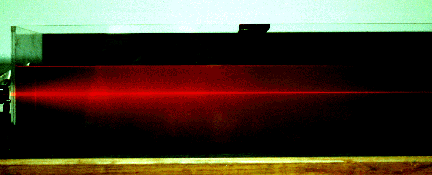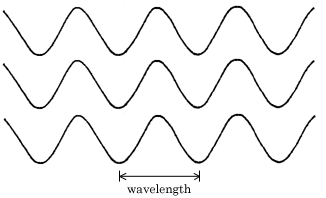

CD players. Eye surgery. Science fiction movies. These are some of the ways in which lasers are
used but there are many others, as well. They are often used in scientific research as a tool for studying other materials and for information retrieval and recording. Scientists have also found a use for them in time-keeping.
A laser can be thought of as simply a light source that emits only one wavelength of light. Unlike a standard light bulb or sunlight, a laser emits only one wavelength, one tiny portion of the spectrum. To learn more about the spectrum of light go to the Color and Light Reading.
Not only do lasers emit only one wavelength, the light waves that make up the laser beam tend to line up , trough-to-trough and crest-to-crest: the laser is called coherent or "in phase".

These are the two special properties of lasers: monochromatic (one-wavelength) emission and coherence. Because of these special properties, lasers can tell us information about an object when the laser light is shined on the object and then interfered with itself. This interference is a lot like colliding waves in a pool or ocean. When two waves collide, if the peaks meet, then the waves will add together and you'll see a bigger wave. If a peak and a trough collide, then the waves will subtract each other and you'll see a flat spot.
You can see for yourself how this interference pattern looks. Shine a laser on a rough white surface, such as a projector screen or a wall on the far side of the room. View the spot that the laser makes on the surface. Do you see little "speckles" of light and dark areas? This is called a speckle pattern and is due to the interference of the laser light as it reflects off the surface.
Move around. Does the speckle pattern move, too? If you wear eyeglasses, take them off and view the spot. Can you still see it? If you move around with your eyeglasses off, which way does the speckle pattern move? Compare your observations with a friend who has eyeglasses.
What's a laser good for? Go to the Hologram Reading.
Page authored by the ACEPT W3 Group
Department of Physics and Astronomy, Arizona State University, Tempe, AZ 85287-1504
Copyright © 1995-2000 Arizona Board of Regents. All rights reserved.